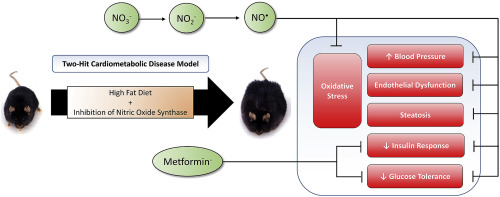当前位置:
X-MOL 学术
›
Nitric Oxide
›
论文详情
Our official English website, www.x-mol.net, welcomes your
feedback! (Note: you will need to create a separate account there.)
Head-to-head comparison of inorganic nitrate and metformin in a mouse model of cardiometabolic disease.
Nitric Oxide ( IF 3.2 ) Pub Date : 2020-02-04 , DOI: 10.1016/j.niox.2020.01.013 Isabel Cordero-Herrera 1 , Drielle D Guimarães 1 , Chiara Moretti 1 , Zhengbing Zhuge 1 , Huirong Han 1 , Sarah McCann Haworth 1 , Arturo Eduardo Uribe Gonzalez 1 , Daniel C Andersson 2 , Eddie Weitzberg 3 , Jon O Lundberg 1 , Mattias Carlström 1
Nitric Oxide ( IF 3.2 ) Pub Date : 2020-02-04 , DOI: 10.1016/j.niox.2020.01.013 Isabel Cordero-Herrera 1 , Drielle D Guimarães 1 , Chiara Moretti 1 , Zhengbing Zhuge 1 , Huirong Han 1 , Sarah McCann Haworth 1 , Arturo Eduardo Uribe Gonzalez 1 , Daniel C Andersson 2 , Eddie Weitzberg 3 , Jon O Lundberg 1 , Mattias Carlström 1
Affiliation

|
BACKGROUND/PURPOSE
Unhealthy dietary habits contribute to the increasing incidence of metabolic syndrome and type 2 diabetes (T2D), which is accompanied by oxidative stress, compromised nitric oxide (NO) bioavailability and increased cardiovascular risk. Apart from lifestyle changes, biguanides such as metformin are the first-line pharmacological treatment for T2D. Favourable cardiometabolic effects have been demonstrated following dietary nitrate supplementation to boost the nitrate-nitrite-NO pathway. Here we aim to compare the therapeutic value of inorganic nitrate and metformin alone and their combination in a model of cardiometabolic disease.
EXPERIMENTAL APPROACH
Mice were fed control or high fat diet (HFD) for 7 weeks in combination with the NO synthase (NOS) inhibitor l-NAME to induce metabolic syndrome. Simultaneously, the mice were treated with vehicle, inorganic nitrate, metformin or a combination of nitrate and metformin in (drinking water). Cardiometabolic functions were assessed in vivo and tissues were collected/processed for analyses.
KEY RESULTS
HFD + L-NAME was associated with cardiometabolic dysfunction, compared with controls, as evident from elevated blood pressure, endothelial dysfunction, impaired insulin sensitivity and compromised glucose clearance as well as liver steatosis. Both nitrate and metformin improved insulin/glucose homeostasis, whereas only nitrate had favourable effects on cardiovascular function and steatosis. Mechanistically, metformin and nitrate improved AMPK signalling, whereas only nitrate attenuated oxidative stress. Combination of nitrate and metformin reduced HbA1c and trended to further increase AMPK activation.
CONCLUSION/IMPLICATIONS
Nitrate and metformin had equipotent metabolic effects, while nitrate was superior regarding protection against cardiovascular dysfunction and liver steatosis. If reproduced in future clinical trials, these findings may have implications for novel nutrition-based strategies against metabolic syndrome, T2D and associated complications.
中文翻译:

心脏代谢疾病小鼠模型中无机硝酸盐和二甲双胍的头对头比较。
背景/目的不健康的饮食习惯会导致代谢综合征和2型糖尿病(T2D)的发病率增加,并伴有氧化应激,一氧化氮(NO)生物利用度降低和心血管风险增加。除了改变生活方式之外,双胍类药物(如二甲双胍)是T2D的一线药物治疗。饮食中补充硝酸盐以增强硝酸盐-亚硝酸盐-NO途径后,已显示出良好的心脏代谢作用。在这里,我们旨在比较无机硝酸盐和二甲双胍及其组合在心脏代谢疾病模型中的治疗价值。实验方法与NO合酶(NOS)抑制剂1-NAME一起喂养小鼠对照或高脂饮食(HFD)7周,以诱导代谢综合征。同时,用(饮用水)中的媒介物,无机硝酸盐,二甲双胍或硝酸盐和二甲双胍的组合治疗小鼠。在体内评估心脏代谢功能,并收集/处理组织以进行分析。关键结果与对照组相比,HFD + L-NAME与心脏代谢功能障碍相关,从血压升高,内皮功能障碍,胰岛素敏感性受损,葡萄糖清除率受损以及肝脂肪变性可以明显看出。硝酸盐和二甲双胍均可改善胰岛素/葡萄糖的体内稳态,而仅硝酸盐对心血管功能和脂肪变性有有利作用。从机理上讲,二甲双胍和硝酸盐可改善AMPK信号传导,而仅硝酸盐可减轻氧化应激。硝酸盐和二甲双胍的组合降低HbA1c,并趋于进一步增加AMPK激活。结论/结论硝酸盐和二甲双胍具有同等的代谢作用,而硝酸盐在预防心血管功能障碍和肝脂肪变性方面具有优越性。如果在未来的临床试验中转载,这些发现可能对新的基于营养的新陈代谢综合征,T2D和相关并发症的治疗策略有影响。
更新日期:2020-02-04
中文翻译:

心脏代谢疾病小鼠模型中无机硝酸盐和二甲双胍的头对头比较。
背景/目的不健康的饮食习惯会导致代谢综合征和2型糖尿病(T2D)的发病率增加,并伴有氧化应激,一氧化氮(NO)生物利用度降低和心血管风险增加。除了改变生活方式之外,双胍类药物(如二甲双胍)是T2D的一线药物治疗。饮食中补充硝酸盐以增强硝酸盐-亚硝酸盐-NO途径后,已显示出良好的心脏代谢作用。在这里,我们旨在比较无机硝酸盐和二甲双胍及其组合在心脏代谢疾病模型中的治疗价值。实验方法与NO合酶(NOS)抑制剂1-NAME一起喂养小鼠对照或高脂饮食(HFD)7周,以诱导代谢综合征。同时,用(饮用水)中的媒介物,无机硝酸盐,二甲双胍或硝酸盐和二甲双胍的组合治疗小鼠。在体内评估心脏代谢功能,并收集/处理组织以进行分析。关键结果与对照组相比,HFD + L-NAME与心脏代谢功能障碍相关,从血压升高,内皮功能障碍,胰岛素敏感性受损,葡萄糖清除率受损以及肝脂肪变性可以明显看出。硝酸盐和二甲双胍均可改善胰岛素/葡萄糖的体内稳态,而仅硝酸盐对心血管功能和脂肪变性有有利作用。从机理上讲,二甲双胍和硝酸盐可改善AMPK信号传导,而仅硝酸盐可减轻氧化应激。硝酸盐和二甲双胍的组合降低HbA1c,并趋于进一步增加AMPK激活。结论/结论硝酸盐和二甲双胍具有同等的代谢作用,而硝酸盐在预防心血管功能障碍和肝脂肪变性方面具有优越性。如果在未来的临床试验中转载,这些发现可能对新的基于营养的新陈代谢综合征,T2D和相关并发症的治疗策略有影响。











































 京公网安备 11010802027423号
京公网安备 11010802027423号